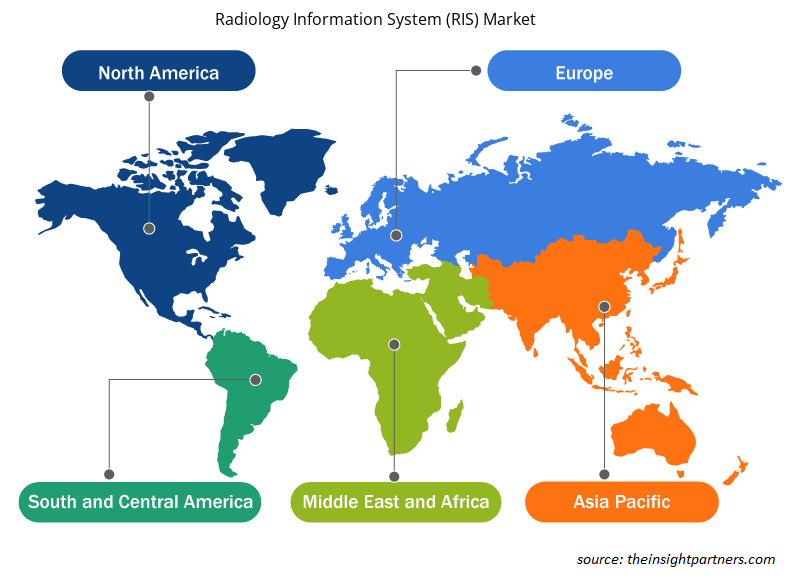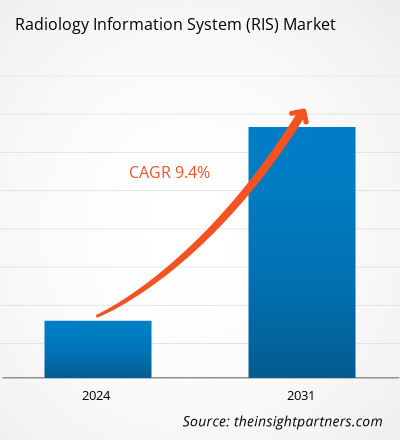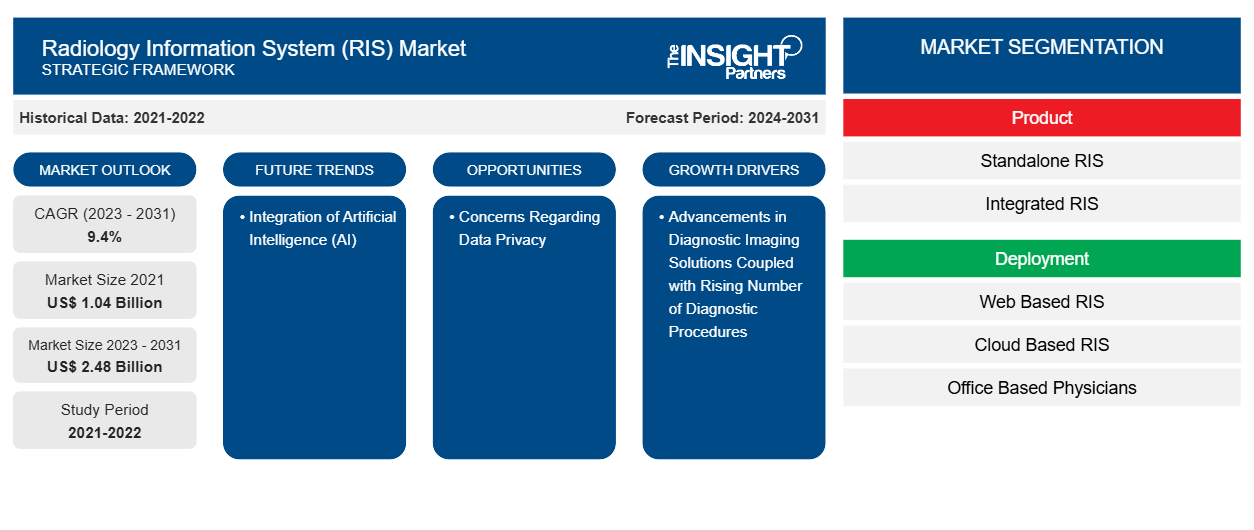2021年の放射線情報システム(RIS)市場規模は10億4,000万米ドルで、2023年の20億米ドルから2031年には24億8,000万米ドルに達すると予測されています。市場は2023年から2031年にかけて9.4%のCAGRを記録すると予想されています。放射線情報システム(RIS)に対する認識の高まりは、健康リスクの少なさと発展途上地域での導入率の高さから、放射線情報システム(RIS)市場の主要トレンドであり続けると思われます。
放射線情報システム (RIS) 市場分析
市場の主な成長要因には、慢性疾患の発生率の上昇、医療情報技術システムへのアクセス、がん研究への政府資金提供などがあります。さらに、慢性疾患の負担は世界中で増加しており、人口の高齢化が進んでいます。また、がん、関節炎、心血管疾患、糖尿病などの生活習慣病は、この市場の成長の主な要因の一部です。がん症例の増加により、適切な診断のための放射線サービスへの注目が高まると予想され、放射線情報システムの需要が増加すると予想されます。がんなどの慢性疾患の増加により、放射線情報システムの需要が高まっています。ただし、調査期間中は、設置コストの高さと熟練労働者の不足が市場の成長を妨げると予想されます。
放射線情報システム (RIS) 市場の概要
RIS は、放射線科および画像診断センターの業務を管理および合理化するために設計された専門的なヘルスケア ソフトウェアです。RIS は、放射線画像、患者情報、および関連データを保存、管理、配布します。機械学習、ディープラーニング、ヘルスケアにおける AI 統合などの継続的な技術進歩により、放射線科システムの精度と効率が向上します。さらに、患者ケアの改善とワークフローの合理化を目的とした統合ヘルスケア ソリューションの需要が高まり、RIS の採用が進んでいます。政府の規制や取り組みも、医療データと記録の標準化を促進しています。また、ヘルスケア IT サービスの採用に対するインセンティブも提供しており、市場の成長機会にプラスの影響を与えることが期待されています。
要件に合わせてレポートをカスタマイズする
このレポートの一部、国レベルの分析、Excelデータパックなど、あらゆるレポートを無料でカスタマイズできます。また、スタートアップや大学向けのお得なオファーや割引もご利用いただけます。
-
このレポートの主要な市場動向を入手してください。この無料サンプルには、市場動向から見積もりや予測に至るまでのデータ分析が含まれます。
放射線情報システム(RIS)市場の推進要因と機会RIS) Market Drivers and Opportunities
診断画像ソリューションの進歩が市場を有利にする
デジタル画像の導入により、放射線学の分野は一変しました。従来のフィルムベースの画像からデジタル形式への移行が促進され、データ管理が最適化され、アクセス性が向上しました。デジタル画像処理によって、画像品質も大幅に向上しました。RIS により、医療スタッフは入院患者と外来患者の両方の予約を設定できます。放射線学は、医療サービスのコンピューター管理に向けて進歩し、放射線科部門とそのユーザー間のコスト効率が高く迅速なコミュニケーションの需要に応えてきました。ここ数年、医療における診断目的の画像モダリティにはさまざまな開発が行われています。近年、 AI 支援 X 線解釈、デュアルエネルギー画像、トモシンセシス、コンピューター支援診断、自動画像ステッチング、デジタルモバイルラジオグラフィーなど、デジタルラジオグラフィーで多くの進歩がありました。これらの進歩により、画像品質が向上し、患者ケアの改善と患者転帰の改善に役立っています。さらに、デジタルラジオグラフィーを使用すると、繰り返しの画像撮影の必要性が減り、放射線被ばく量が少なくなるという利点があります。catalysed the transition from traditional film-based imaging to digital formats, optimized data management, and increased accessibility. Digital image processing also led to significant improvements in image quality. RIS allows healthcare staff to set appointments for individuals on both inpatient and outpatient bases. Radiology has advanced toward computerized management in the health service and has responded to the demand for cost-efficient and rapid communication between departments of radiology and their users. In the last few years, there have been various developments in imaging modalities within healthcare for diagnostic purposes. In recent years, many advances have been made in tomosynthesis, computer-aided diagnosis, automatic image stitching, and digital mobile radiography. These advances have resulted in improved image quality, helping to improve patient care and achieve better patient outcomes. In addition, using digital radiography reduces the need for repeat imaging, which has the advantage of lower radiation exposure.
新興国における医療ITサービスの導入拡大 – 放射線情報システム(RIS)市場の成長機会
世界的に、需要を満たすために放射線科サービスに技術を導入する必要性が高まっています。RISの将来は、人工知能(AI)と機械学習(ML)の活用にあります。AIアルゴリズムは、放射線科医が画像を分析し、異常を検出し、意思決定をサポートするのに役立ちます。MLアルゴリズムは、大量のデータから継続的に学習し、診断と治療計画を改良することができます。インターネットとモバイル技術、遠隔放射線診断、人工知能、医療画像情報科学の発展、ポータブルまたはモバイルの医療画像機器による接続性の向上により、どの国の遠隔地でも、より優れた医療と診断を受けることができます。さらに、発展途上国では、確立されたブランドとしてケアの国際化を経験しているため、医療システムはより技術的にフレンドリーになっています。たとえば、米国を拠点とするクリーブランドクリニックはUAEでの市場を拡大し、機械学習とAIを搭載したプライマリケア診断アプリであるイギリスの新興企業バビロンは、中国とルワンダに参入しました。
放射線情報システム (RIS) 市場レポートのセグメンテーション分析
放射線情報システム (RIS) 市場分析の導出に貢献した主要なセグメントは、製品、展開、コンポーネント、およびエンド ユーザーです。
- 製品に基づいて、放射線情報システム(RIS)市場は、スタンドアロンRISと統合RISに分かれています。2023年には、統合RISセグメントが市場で最大のシェアを占め、同じセグメントが予測期間中に最高のCAGRを記録すると予想されています。RIS) market is bifurcated into standalone RIS and integrated RIS. In 2023, integrated RIS segment held the largest share of the market, and the same segment is anticipated to register the highest CAGR during the forecast period.
- 展開別に見ると、市場はウェブベースの RIS、クラウドベースの RIS、オンプレミス RIS に分類されます。2023 年には、ウェブベースの RIS セグメントが市場で最大のシェアを占めました。ただし、クラウドベースの RIS セグメントは、2023 年から 2031 年の間に最高の CAGR を記録すると予想されています。RIS, cloud-based RIS, on-premises RIS. In 2023, web-based RIS segment held the largest share of the market. However, the cloud-based RIS segment is anticipated to register the highest CAGR during 2023–2031.
- コンポーネントに基づいて、放射線情報システム(RIS)市場は、ハードウェア、ソフトウェア、およびサービスに分類されます。2023年には、サービスセグメントが市場で最大のシェアを占め、ソフトウェアセグメントは予測期間中に最高のCAGRを記録すると予想されます。RIS) market is categorized into hardware, software, and services. In 2023, services segment held the largest share of the market, and the software segment is anticipated to register the highest CAGR during the forecast period.
- エンドユーザーの観点から見ると、市場は診療所を拠点とする医師、病院、緊急医療サービス提供者に分かれています。2023年には病院セグメントが市場で最大のシェアを占め、予測期間中に同セグメントが最高のCAGRを記録すると予測されています。CAGR during the forecast period.
放射線情報システム (RIS) の地域別市場シェア分析RIS) Market Share Analysis by Geography
放射線情報システム (RIS) 市場レポートの地理的範囲は、主に北米、アジア太平洋、ヨーロッパ、中東およびアフリカ、南米/中南米の 5 つの地域に分かれています。RIS) market report is mainly divided into five regions: North America, Asia Pacific, Europe, Middle East & Africa, and South America/South & Central America.
北米は放射線情報システム(RIS)市場を支配してきました。この地域の市場需要は、医療インフラへの政府投資、医療用画像に関する意識の高まり、RISの導入に伴うメリットなど、いくつかの要因により、大幅な成長が見込まれています。米国では、この地域の画像センターの数が多いこと、技術進歩のペースが速いこと、高齢者人口の増加、コンピューター支援診断の需要増加などの要因が、この市場の主要な成長要因となっています。また、心臓血管、整形外科、歯科、腫瘍学の画像診断用のRISの高度なシステムの開発に携わっているさまざまな企業の存在が、市場の成長に成長の機会をもたらすと予想されています。しかし、アジア太平洋地域は、医療インフラの改善によるこの地域の医療情報技術産業の成長や、消費者による高度な医療技術の採用率の上昇などの要因により、今後数年間で最も高いCAGRで成長すると予測されています。RIS) market. The demand for the market in the region is expected to observe growth at a significant rate because of several factors such as government investment in healthcare infrastructure, increasing awareness regarding the medical imaging as well as the benefits associated with implementation of RIS. In the US factors such as large number of imaging centers in this region, swift pace of technological advancements, growing geriatric population and increasing demand for computer aided diagnosis, are some of the key growth drivers of this market. Also, presence of various companies engaged in developing advanced systems of RIS for diagnostic imaging of cardiovascular, orthopedic, dental and oncology is expected to offer growth opportunities for the market growth. However, Asia Pacific is predicted to grow with the highest CAGR in the coming years owing to factors such growth of the healthcare information technology industry in this region due to improving healthcare infrastructure and rise in rate of adoption of advanced health care techniques by consumers.
放射線情報システム (RIS) 市場の地域別分析
予測期間を通じて放射線情報システム (RIS) 市場に影響を与える地域的な傾向と要因は、Insight Partners のアナリストによって徹底的に説明されています。このセクションでは、北米、ヨーロッパ、アジア太平洋、中東およびアフリカ、南米および中米にわたる放射線情報システム (RIS) 市場のセグメントと地理についても説明します。

- 放射線情報システム(RIS)市場の地域別データを入手
放射線情報システム(RIS)市場レポートの範囲
| レポート属性 | 詳細 |
|---|---|
| 2021年の市場規模 | 10億4千万米ドル |
| 2031年までの市場規模 | 24億8千万米ドル |
| 世界のCAGR(2023年~2031年) | 9.4% |
| 履歴データ | 2021-2022 |
| 予測期間 | 2024-2031 |
| 対象セグメント |
製品別
|
| 対象地域と国 |
北米
|
| 市場リーダーと主要企業プロフィール |
|
放射線情報システム(RIS)市場のプレーヤー密度:ビジネスダイナミクスへの影響を理解する
放射線情報システム (RIS) 市場は、消費者の嗜好の変化、技術の進歩、製品の利点に対する認識の高まりなどの要因により、エンドユーザーの需要が高まり、急速に成長しています。需要が高まるにつれて、企業は提供内容を拡大し、消費者のニーズを満たすために革新し、新たなトレンドを活用し、市場の成長をさらに促進しています。
市場プレーヤー密度とは、特定の市場または業界内で活動している企業または会社の分布を指します。これは、特定の市場スペースに、その規模または総市場価値と比較して、どれだけの競合相手 (市場プレーヤー) が存在するかを示します。
放射線情報システム(RIS)市場で事業を展開している主要企業は次のとおりです。
- フィリップスNV社、
- シーメンス ヘルシナーズ AG、
- バイエルAG、
- セルナーコーポレーション、
- ゼネラル・エレクトリック・カンパニー、
- マッケソンコーポレーション
免責事項:上記の企業は、特定の順序でランク付けされていません。

- 放射線情報システム(RIS)市場のトップキープレーヤーの概要を入手
放射線情報システム (RIS) 市場のニュースと最近の動向
放射線情報システム (RIS) 市場は、重要な企業出版物、協会データ、データベースを含む一次調査および二次調査後の定性的および定量的データを収集することによって評価されます。以下は、放射線情報システム (RIS) 市場の動向の一覧です。
- 大手ヘルスケア ソフトウェア プロバイダーの Royal Solutions Group は、Concord Technologies とのパートナーシップの拡大を発表します。Concord の最先端のデータ処理ソリューションである Practical AI スイートの追加テクノロジーを統合することで、入力されたメモと手書きのメモの両方を簡単にスキャンし、データを抽出してワークフローに統合できます。これにより、医療機関が注文の入力、インデックス作成、事前承認を処理する方法が変革されます。これらの重要なプロセスを自動化することで、医療従事者は事務作業ではなく患者のケアに集中できるようになります。(Royal Solutions Group, LLC、プレスリリース、2024 年)
- インド有数の医療機関であるマニパル病院は、富士フイルム インドと契約を締結しました。長期契約では、マニパル病院に富士フイルム インドが提供する大規模な画像保管・通信システム (PACS) が提供されます。PACS により、機密情報、フィルム、レポートを手動で保存、取得、送信する必要がなくなります。(富士フイルム インド プライベート リミテッド、ニュース、2023 年)
- PARATUS が IMAGE Information Systems の過半数の株式を取得。IMAGE は、世界中の画像センターや病院にサービスを提供する PACS の大手プロバイダーです。PARATUS によるこの投資は、世界をリードするヘルスケア ソフトウェアおよび IT サービス プロバイダーを確立するための戦略的な基盤となります。(RADiQ IMAGE Information Systems、ニュース、2023 年)
- フィリップスは、RSNA で放射線科ワークフローのあらゆるステップでインテリジェンスを活用して診断の信頼性を高める、新しい AI 強化インフォマティクス ソリューションを発表しました。(Koninklijke Philips NV、ニュース、2022 年)
放射線情報システム (RIS) 市場レポートの対象範囲と成果物
「放射線情報システム(RIS)市場規模と予測(2021〜2031年)」レポートでは、以下の分野をカバーする市場の詳細な分析を提供しています。
- 対象範囲に含まれるすべての主要市場セグメントの世界、地域、国レベルでの市場規模と予測
- 市場の動向(推進要因、制約、主要な機会など)
- 今後の主な動向
- 詳細なPEST/ポーターの5つの力とSWOT分析
- 主要な市場動向、主要プレーヤー、規制、最近の市場動向を網羅した世界および地域の市場分析
- 市場集中、ヒートマップ分析、主要プレーヤー、最近の動向を網羅した業界の状況と競争分析
- 詳細な企業プロフィール
- 過去2年間の分析、基準年、CAGRによる予測(7年間)
- PEST分析とSWOT分析
- 市場規模価値/数量 - 世界、地域、国
- 業界と競争環境
- Excel データセット
最新レポート
お客様の声
購入理由
- 情報に基づいた意思決定
- 市場動向の理解
- 競合分析
- 顧客インサイト
- 市場予測
- リスク軽減
- 戦略計画
- 投資の正当性
- 新興市場の特定
- マーケティング戦略の強化
- 業務効率の向上
- 規制動向への対応























 無料サンプルを入手 - 放射線情報システム(RIS)市場
無料サンプルを入手 - 放射線情報システム(RIS)市場